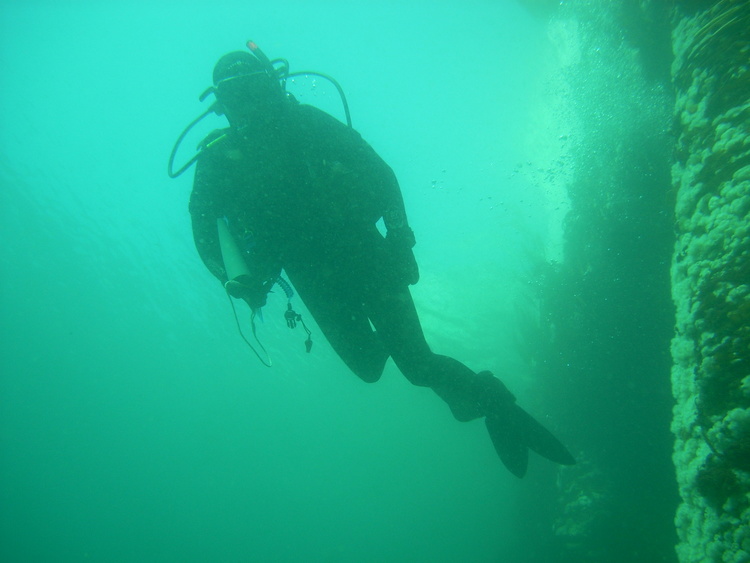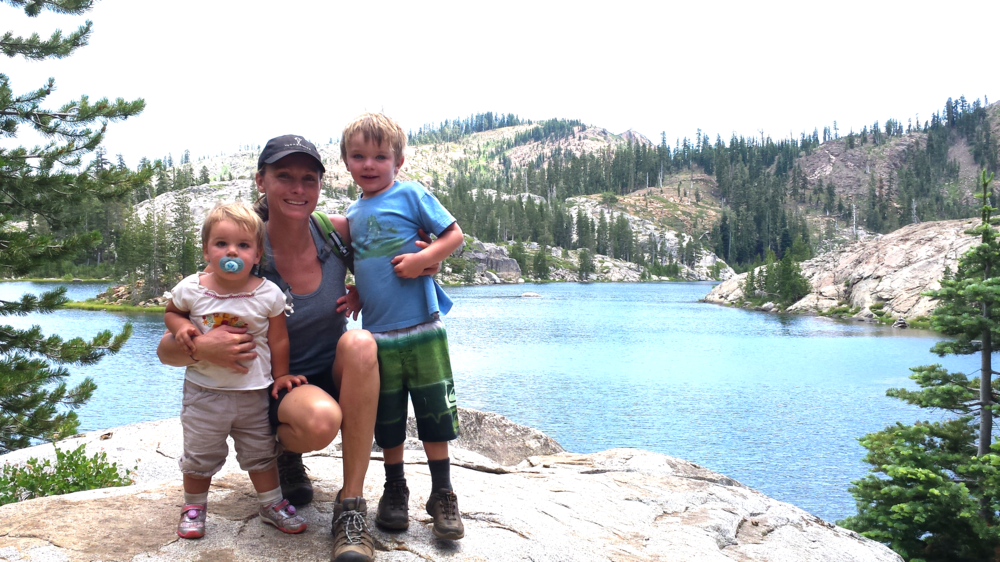Written by Amelia Tiemann
July 27, 2017

Kristin Zaitz is mother to Oliver, 6, and Kate, 3. She is a civil engineer and project manager specializing in seismic analysis and design at Diablo Canyon nuclear power plant in San Luis Obispo, and is co-founder of Mothers for Nuclear. This week, she spoke on and facilitated multiple panels about leadership, activism, and advocating at the US Women In Nuclear Conference in San Francisco. The following is an excerpt from the Mother’s for Nuclear website, and tells Kristen’s story, in her own words.
Check out more awesome stories at mothersfornuclear.org

I am floating face up, my back to the ocean floor, watching seals flip above me, fish race beside me, and sunlight shining through a forest of bright green kelp waving at me. The scene is so sublime I almost forget that I am at work.
I am a civil engineer and project manager at Diablo Canyon, California’s last surviving nuclear plant. One of the unexpected perks of my career is scuba diving. I spent one memorable birthday in the discharge cove, where the hot water exits the plant, swimming with violently beautiful leopard sharks.
I lived until the age of five in a beach town, Cayucos, just up the road. My dad worked as little as possible — he called it his “early retirement” — so he could focus on more important things, like surfing and picking guitar.
When the kids started coming, he put his early retirement on hold and got a real job. We moved into a tiny house surrounded by wide open land in the Sierra Nevada foothills. We lacked air conditioning and so my brothers and sister and I spent our free time climbing trees, making forts and roaming the oak forests.
My parents taught us about leaving wilderness more pristine than we found it. They led all four of us kids out in the fields to pull up non-native thistles by hand, instead of dousing them with weed killer. Dad took me backpacking as soon as I was old enough to carry a pack. We slept under the stars and marveled at the expanse of the sky, and our small place in a big universe.
My uncle led me through miles and days and weeks of the California landscape, using his training as a geologist to inspire conversation about our surroundings. We took rubbings of glacial striations and hypothesized about how valleys and mountains and rivers changed through the years. He helped me complete my high school senior project on my then hero, John Muir.
In nature you learn that food doesn’t come from the grocery store and water doesn’t come from the faucet. When you see the river your water comes from you think twice about letting it run when brushing your teeth.
I spent many childhood nights sleeping outdoors. Some of this was by necessity. All four of us kids shared one tiny room, and I was ready for some privacy when I approached my teenage years. Since that wasn’t possible indoors, I slept out on the porch. When I was trying to get pregnant, my midwife told me I needed to let go of stress. I started sleeping under the stars in my front yard to relax. It worked.
My teenage years were confusing. Should I try to hang out with cool friends and go to parties and shopping and have the right clothes? I wanted to go out into the world and not wait for a man to take me. My friends and I would hike everywhere. We strapped our snowboards to our packs and, in the middle of July, found the shady sides of mountains with snow still on them, and were able to carve a few turns.
Nature provided me with the big picture. It took me away from society’s distractions — from the focus on having the right clothes and right friends to exploration and adventure. When it was time for me to pick a major in college, my dad encouraged civil engineering. “If you do that, you can spend time outdoors.”
IN COLLEGE I WAS TAUGHT THAT NUCLEAR POWER WAS BAD FOR THE ENVIRONMENT, AND THAT BEING ANTI-NUCLEAR WAS A PREREQUISITE TO CALLING YOURSELF AN ENVIRONMENTALIST.
I wasn’t really sure what I thought. In a public speaking class I was given an assignment to present a controversial topic. I picked nuclear power and decided to do my own research. I came away convinced that everything people said about nuclear was wrong. My professor had given my previous speech an A+. On this one he gave me a C and explained that it wasn’t because it was a bad speech but rather that he just didn’t agree.

At the end of college, I accepted an internship offer at Diablo Canyon. I was wary. It was at a time when Pacific Gas & Electric’s reputation was tattered. Electricity reform had left PG&E unable to raise rates, while the Texas energy company, Enron, was manipulating natural gas prices. PG&E eventually went bankrupt. But I figured I’d learn the dirt about the company and then probably leave.
I ended up loving it. Most everyone was at least 10 years older than me, male and fatherly. Most took me under their wing, walked me around the plant and showed me the ropes. I came to see that these were a bunch of great people working on what they thought was a great thing. There were a few awkward moments being one of the few young females on site, but the response from PG&E was swift and supportive. I never doubted they would back me up, and felt treated like part of the family.
Everyone who works at Diablo marvels at the spectacular setting. When humpback whales breach in front of the plant, someone will announce, “The whales are breaching!” and we go outside to watch. The plant is surrounded by tide pools in pristine condition because they haven’t been trampled by tourists. The hills are covered with old-growth oak trees. The land around Diablo is kept as it has been for thousands of years, untouched by development and the surging tide of humanity.
One of my most exciting jobs was inspecting the two containment domes that gaze like sentries over the Pacific Ocean. To get to the top, you have to climb several ladders, until you arrive at a small circular platform at the top of the dome. We put wires around the platform and rappelled down the side. I found the containment domes to be in excellent condition.
Knowledge is power. When I was pregnant, I inspected the inside of a containment dome during a refueling outage. I knew from my dosimeter that I got less radiation exposure than my coworker who ate a banana that day. Part of what so upsets me about the thought of closing Diablo Canyon is that I know from personal experience it is in such good condition.
A FEW WEEKS AGO, MY THREE YEAR-OLD DAUGHTER, KATE, RAN AWAY FROM HOME.

When I discovered she was missing I fought back panic and I ran to all of her usual hiding places — behind the chicken coop, between the garden boxes— finding nothing. I ran into the street and yelled her name, frantically searching between parked cars. Looking back at the house, I saw my headstrong girl crouched under the olive tree, backpack in tow. Emotions flooded through me. My fears turned into relief and then into anger and then back again to relief.
I have been feeling the same thing about Diablo Canyon — the feeling that something bad is about to happen, and that I am powerless to stop it. Out of misunderstanding and fear, California may close the best-run nuclear plant in the world and replace it with fossil fuels. In failing to use our heads, we may end up hurting ourselves. My fearful thoughts turn to anger, then relief — I’m not alone in this journey. There is a growing voice of scientists, conservationists and citizens who support Diablo Canyon. I am only one of them.
I have run marathons for the last decade and have started taking Oliver, 6 and Kate, 3 on runs with me. Their little lungs work so hard — I feel glad we live near a nuclear plant, which emits no air pollution, and far away from the polluted skies of Los Angeles and New York much less Beijing or Delhi. Mothers should be upset at the misinformation: we’ve had the wool pulled over our eyes. Air pollution is a carcinogen and causes actual deaths. There is no air pollution from nuclear plants.
As a mother you feel a responsibility to protect your children and the planet they will inherit. But I know we are not going to convince everyone to open their minds. Some, like US House of Representatives Congresswoman Lois Capps, freely admit theirs are closed.
But I reject the idea that mothers reason only with their guts and hearts, and not with their heads. With our success in science, technology, engineering and math (STEM) women are more empowered than ever before. Society and culture played a role: Heather and I had engineer fathers who encouraged and supported us; we could roam freely through the woods and desert without fear of being harmed; we married husbands more supportive than husbands have ever been. Mine — Omega — a strong and gentle carpenter, was always suspicious of Diablo Canyon. Until now. As he’s come to understand the science and engineering he has come to support the plant and me and join me in my upset. He comes to all of the Save Diablo Canyon meetings and brings the kids.
Support for nuclear power is not something that comes naturally to the friends of mine who are herbalists and home-schoolers and mid-wives, including the ones who helped me give birth to Kate underwater, in an inflatable tub in my bedroom. But they love me and trust me. What I find most moving is the willingness of everyone to not just listen but also to ask questions.
Back under the kelp forest, I lazily kick through the gentle current. Diablo sucks in two billion gallons of Pacific Ocean water every day to cool its reactors. One of the many myths about Diablo Canyon is that it is suctioning in giant quantities of marine life. In truth, the large size of the intake means the water is drawn in languidly. I take my time. A fish quite casually swims right up next to me, looks at the intake screens, then at me, and then swims away.
Kristin Zaitz is mother to Oliver, 6, and Kate, 3. She is a civil engineer and project manager specializing in seismic analysis and design at Diablo Canyon nuclear power plant in San Luis Obispo, and is co-founder of Mothers for Nuclear. This article represents her opinion alone and not that of her employer.



